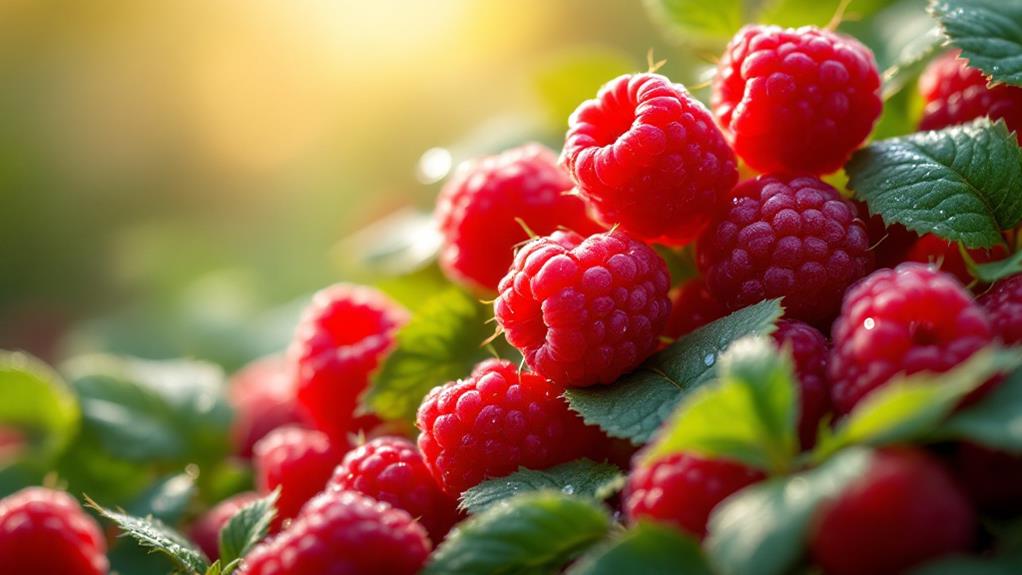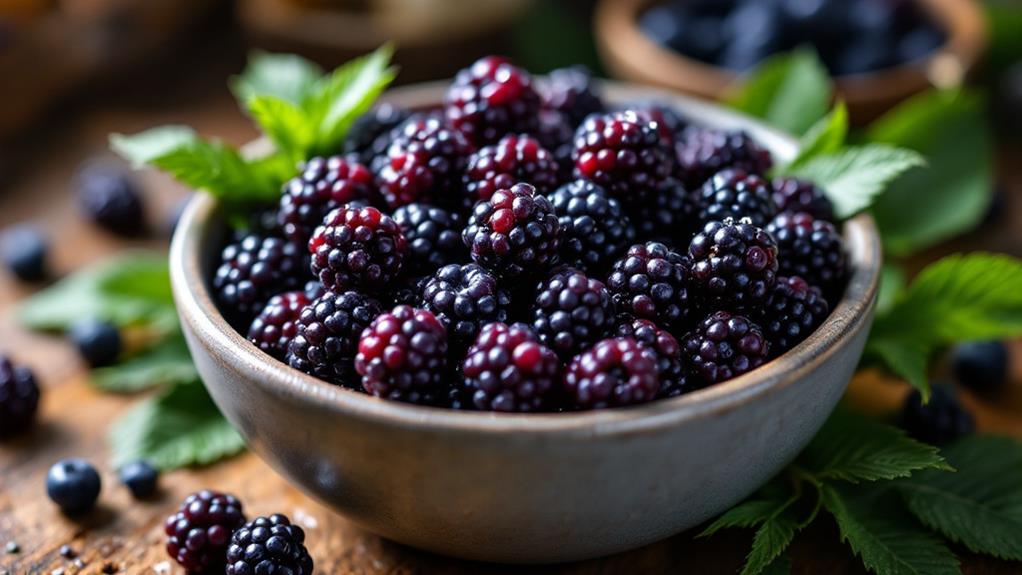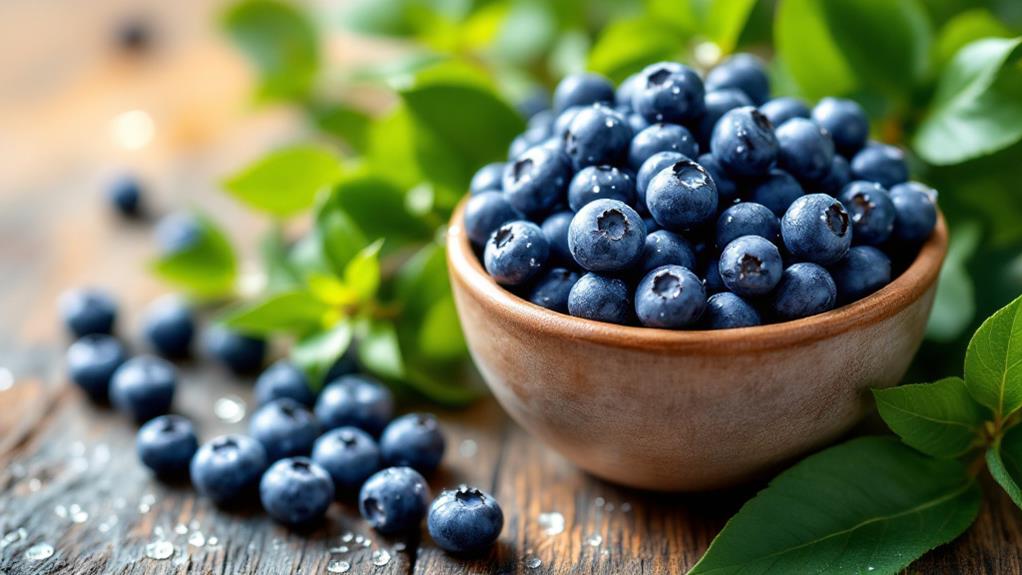Tips for Freezing Berries: How to Preserve Their Flavor and Nutrition
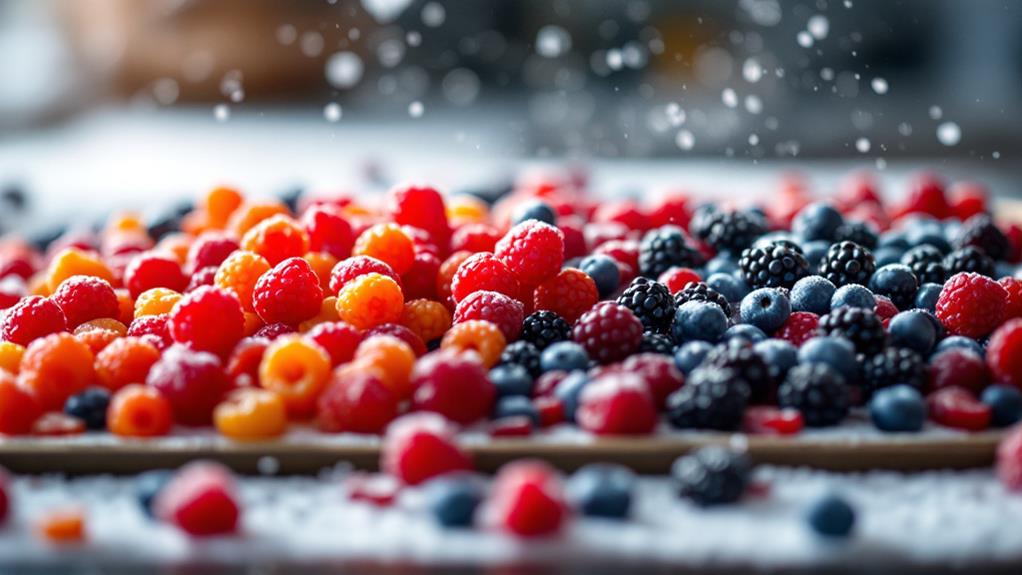
To preserve berry flavor and nutrition, choose ripe, undamaged berries. Skip washing blueberries but rinse other berries gently and dry them thoroughly. Use the flash freezing method by spreading berries in a single layer on a baking sheet until solid, preventing texture loss. Store them in airtight, moisture-resistant bags to avoid freezer burn. Consider sugar or syrup packs for extra sweetness and extended storage. Avoid browning by using ascorbic acid or lemon juice before freezing. Label containers and store berries away from the freezer door. Curious about more tips on getting the most from your stored berries?
Selecting the Best Berries
When you're getting ready to freeze berries, selecting the best ones is crucial to guarantee they maintain their flavor and nutritional value. Start by choosing berries at their peak ripeness, as this is when they're bursting with natural flavor and packed with nutrients. Freezing them at this stage locks in their goodness, ensuring your future dishes taste as fresh as possible.
Inspect each berry carefully for any signs of damage or spoilage. Only high-quality fruit will retain its taste and texture through the freezing process. Damaged berries can negatively affect the entire flavor and nutritional value of your frozen stash. For an added health enhancement, consider selecting organic berries. They reduce your exposure to pesticides and offer better health benefits.
Non-climacteric varieties, like blueberries and raspberries, are excellent choices for freezing since they don't ripen after picking. Make sure to freeze them right away to capture their peak ripeness. To optimize your efforts and save money, buy berries in bulk during their peak season. Not only do you get the best prices, but you're also ensuring you have a plentiful supply of high-quality fruit for all your culinary needs.
Preparing Berries for Freezing
Before you start freezing your berries, a little preparation goes a long way in preserving their quality. Initially, inspect berries carefully to remove any stems, leaves, or damaged fruit. Quality is vital for successful freezing, so confirm you're only working with the best. For most berries, rinse them gently in cold water. This step is fundamental to wash fresh berries effectively. However, if you're dealing with blueberries, skip washing to keep their natural protective bloom intact.
Once washed, lay your berries in a single layer on a clean towel to dry. It's significant to let them become completely dry before freezing, as excess moisture can lead to freezer burn and clumping, reducing their quality and shelf life. Be patient with this step; verifying they're thoroughly dry is key.
Next, line a rimmed baking sheet with unbleached parchment paper. Lay the berries out on the sheet in a single layer, making sure they don't touch. Freeze uncovered until they're solid. This method helps prevent clumping, allowing you to store them more efficiently. Following these steps will guarantee your berries remain delicious and nutritious for months to come.
Flash Freezing Method
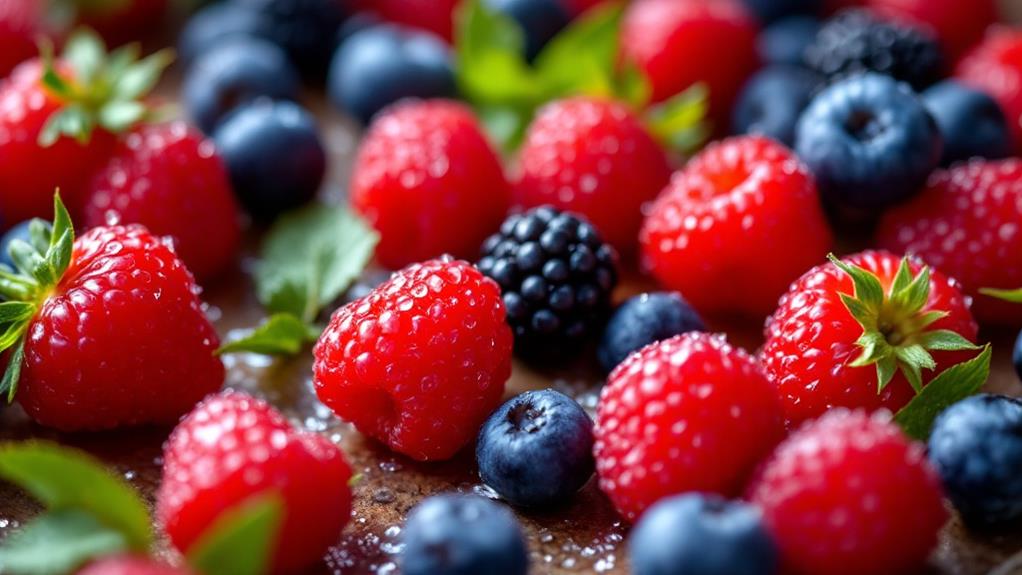
Flash freezing offers a quick and efficient way to preserve your berries' freshness and nutritional value. By rapidly freezing berries in cold, circulating air, this method guarantees they maintain their peak freshness. The process helps retain the berries' flavor and nutrients without requiring any pre-treatment. Unlike other methods, flash freezing doesn't involve blanching, allowing you to enjoy the fruit as you would raw.
To start, arrange your berries in a single layer on a baking sheet. This prevents them from clumping together, making it easy to portion and access later. As the berries freeze individually, flash freezing minimizes the formation of large ice crystals. These crystals can damage the berries' structure, but by keeping them small, you preserve the texture and integrity of the fruit. This method is particularly beneficial if you want to keep your food fresh for smoothies, baking, or snacking.
Choosing Packaging Materials
How do you confirm your frozen berries remain fresh and flavorful? The key lies in choosing the right packaging materials. Start with moisture-resistant freezer bags or containers. They prevent freezer burn and maintain your berries' quality. Airtight packaging is vital to exclude air, which leads to oxidation and a decline in flavor and nutrition. Heavy-duty plastic containers or glass jars designed specifically for freezer storage offer durability and protect against temperature fluctuations.
Don't forget to label each package with the type of berry and the freezing date. This helps you track freshness and guarantees you consume them within their ideal usage time. If you're looking for an eco-friendly option, consider reusable silicone freezer bags. They provide a tight seal, minimizing waste while keeping your berries fresh.
Avoiding Freezer Burn
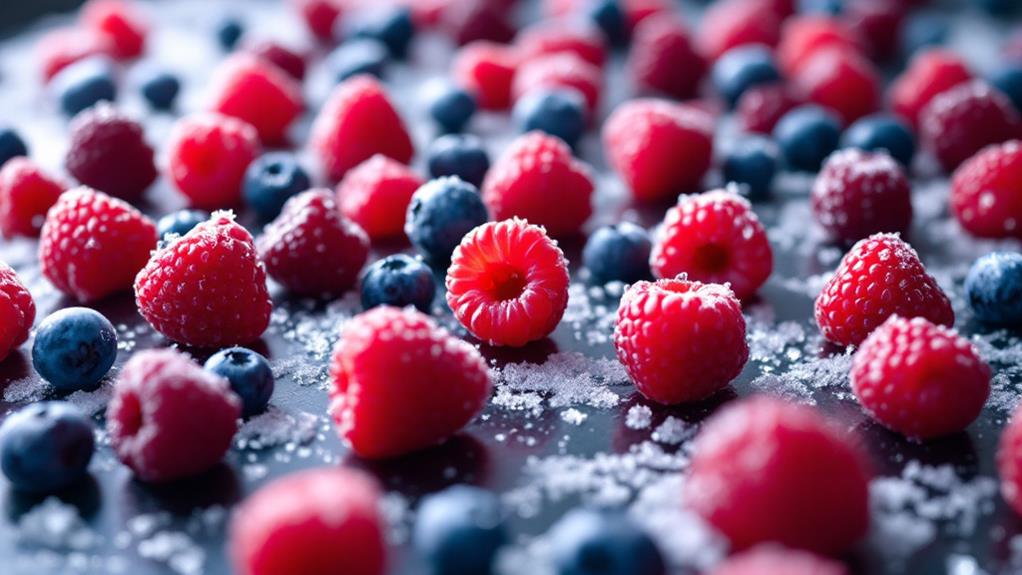
Having chosen the right packaging materials, you can now focus on avoiding freezer burn to keep your berries fresh. Freezer burn occurs when moisture escapes from the frozen berries, leading to dehydration and loss of quality. To prevent this, use moisture and vapor-proof containers or airtight freezer bags to minimize air exposure. This kind of packaging creates a seal that keeps the berries safe from harmful air.
It's essential not to wash the berries before freezing. Excess moisture can lead to ice crystals forming, which contributes to freezer burn. Instead, confirm your berries are completely dry before packaging them. This step minimizes moisture, preventing degradation of texture and flavor during storage.
When you're preparing your berries for storage, label each package with its contents and the freezing date. This practice helps you track the storage time, as frozen berries maintain peak quality when consumed within 6 to 12 months. By organizing your freezer and labeling properly, you prevent unnecessary air exposure from frequent opening and closing.
Sugar and Syrup Packs
Transform your berry freezing routine with sugar and syrup packs, two effective methods to preserve flavor and quality. By using sugar packs, you'll coat your berries with sugar, allowing them to rest before freezing. This technique improves sweetness and prevents freezer burn. For this method, use about ¾ cup of sugar per quart of berries. It's a simple way to guarantee your berries maintain their texture and color while safeguarding their nutrition.
Alternatively, syrup packs require preparing a sugar syrup, typically a 40% sugar solution. This involves dissolving 1 cup of sugar per quart of water, creating a perfect coating for your berries. Syrup packing is ideal if you plan to use your berries in desserts, as it maintains their flavor during freezing. Both methods greatly extend the shelf life of your frozen berries, allowing them to last efficiently for 8 to 12 months.
Whether you choose sugar or syrup, these packing techniques reduce the likelihood of freezer burn and preserve the berries' general quality. By improving flavor and maintaining nutritional value, you'll enjoy delicious, colorful berries long after their harvest season.
Preventing Fruit Browning
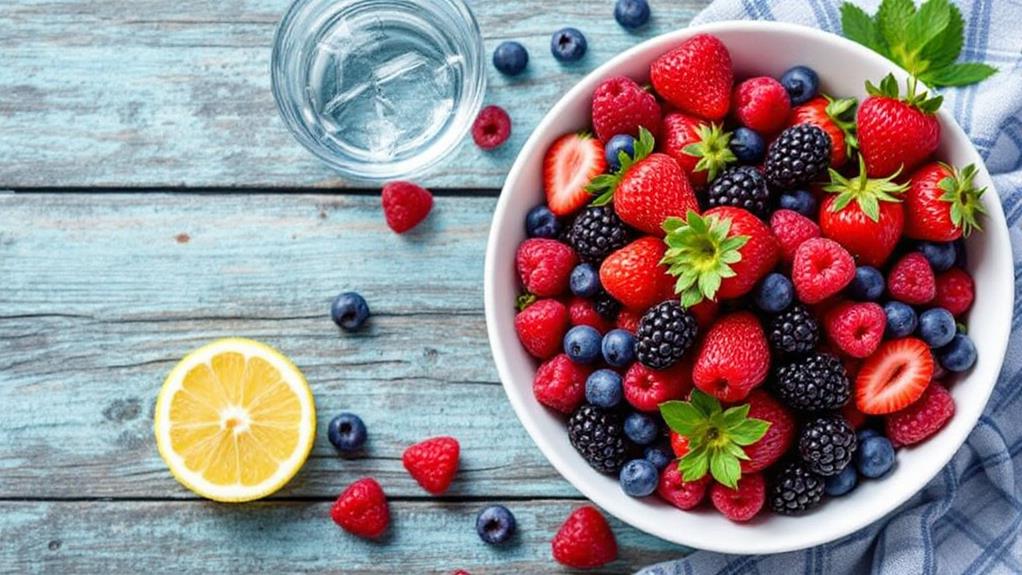
One of the essential steps in freezing fruits like apples and pears is preventing browning, which can occur due to exposure to oxygen. To effectively prevent browning, you can use ascorbic acid. Just apply about 1/8 teaspoon per quart of fruit before freezing. This method is particularly effective against enzymatic browning, ensuring that the fruit retains its natural color and nutritional value.
Another simple trick is to sprinkle lemon juice or citric acid on the cut fruit. This acts as a natural preservative, inhibiting browning caused by oxygen exposure. If you prefer a sweeter option, consider coating the fruit in a sugar solution. Mix 1 cup of sugar with 4 cups of water to create a syrup that can help maintain the fruit's appearance.
Once you've treated the fruit, place it in airtight, moisture-proof containers. This minimizes exposure to air, providing an extra layer of protection against browning. Finally, quick freezing is key. By freezing berries and other fruits immediately after preparation, you lock in their color and nutritional value, preventing any texture degradation that slower freezing might cause. Follow these steps, and your frozen fruits will stay fresh and appealing.
Storing Frozen Berries
After treating your fruits to prevent browning, it's time to focus on storing them properly to maintain their quality. To start, store frozen berries in airtight containers or resealable freezer bags. This step is vital to prevent moisture loss and freezer burn, ensuring your berries retain their best flavor over time. Don't forget to label all containers with the type of berry and the freezing date. This helps you track how long they've been stored and maintain freshness.
Position your frozen berries away from the freezer door. The door is more susceptible to temperature fluctuations, which can degrade the quality of your berries. For the best taste and nutrition, aim to consume frozen berries within 6-12 months. If you vacuum-seal them, they'll last even longer.
A well-organized storage system is also significant. Group similar fruits together. This organization makes it easier to access and use them whenever you're ready to cook or bake. With these steps, you'll enhance the shelf life and quality of your berries, ensuring that they're as delicious and nutritious when you use them as the day you froze them.
Using Frozen Berries
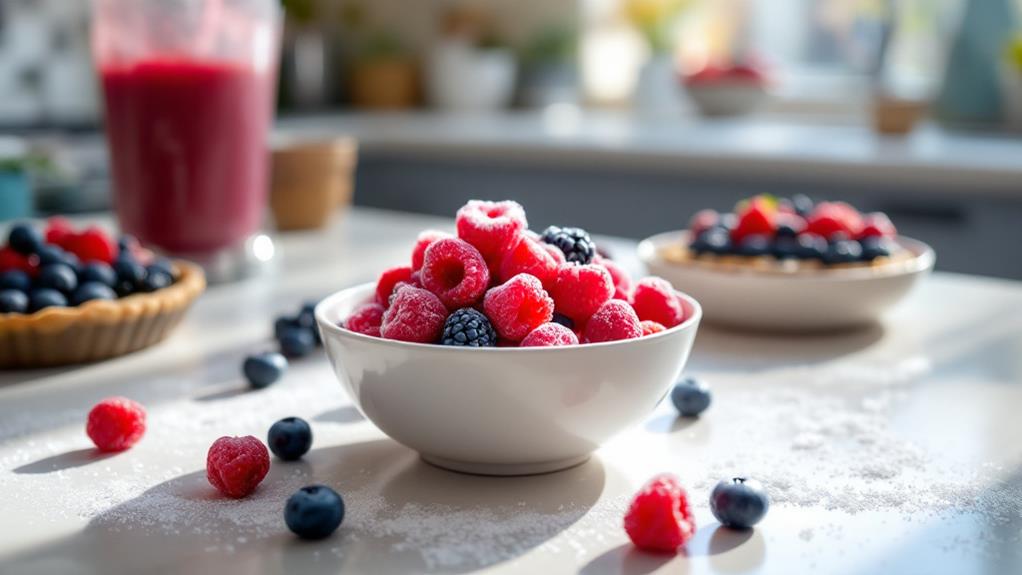
Frozen berries are a fantastic supplement to your culinary toolbox, offering convenience and versatility throughout the year. They preserve their nutritional value through the freezing process, making them an excellent substitute for fresh berries. When using frozen berries, you can add them directly to smoothies, improving texture and flavor without needing to thaw them initially. This method maintains their moisture content and guarantees your drink isn't diluted.
If you're baking, keep in mind that frozen berries release moisture, so expect longer cooking times. This excess moisture content might alter the texture of your baked goods, so adjustments may be necessary depending on your personal preference.
Thawed berries, however, shine in cooked dishes or sauces. Their softer texture post-thawing makes them less suitable for fresh applications but perfect for a burst of flavor and nutrients in your culinary creations. For breakfast, consider using thawed berries as a juicy topping for oatmeal or yogurt.
- Use frozen berries in smoothies for improved texture.
- Bake with frozen berries, adjusting for moisture.
- Incorporate thawed berries into sauces or cooked dishes.
- Enjoy thawed berries as breakfast toppings for extra flavor.
Maximizing Shelf Life
To get the most out of your frozen berries, it's vital to freeze them at their peak ripeness, guaranteeing they retain ideal flavor and nutrition for up to 6-12 months. Start by using air-tight freezer bags or moisture-proof containers to safeguard against freezer burn, which can degrade quality and reduce shelf life. By preventing air exposure, you help preserve the berries' freshness and optimize flavor while assuring nutrition retention over time.
Before freezing, skip washing the berries to maintain their natural protective bloom, a significant factor in extending shelf life. The bloom acts as a barrier, helping to preserve freshness and preventing unnecessary moisture from affecting the berries. Remember to label each package with the berry type and freezing date. This simple step lets you easily track storage time and guarantees you're using them within the recommended timeframe.
Store your frozen berries away from the freezer door to avoid temperature fluctuations. These fluctuations can negatively impact quality, leading to a shorter shelf life. By keeping them in a stable cold environment, you're maximizing shelf life and enjoying delicious, nutritious berries whenever you need them. Follow these steps, and your frozen berries will stay fresh and flavorful.

